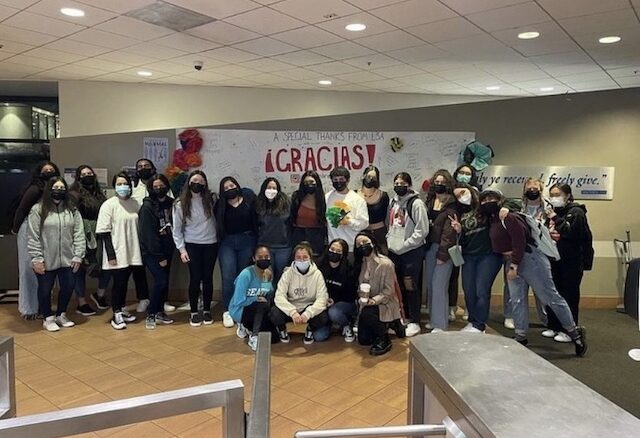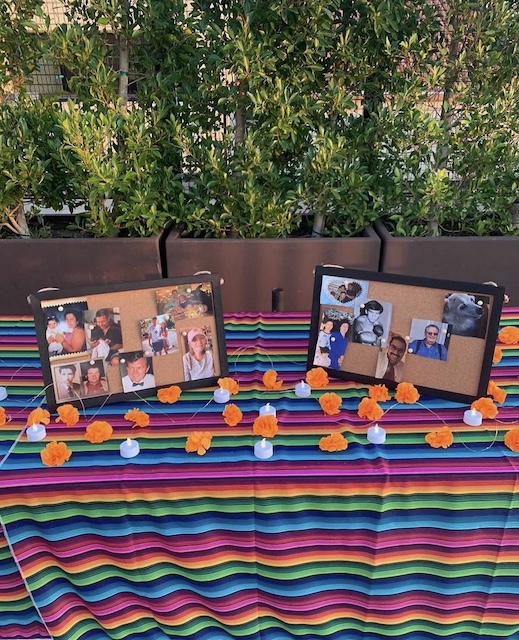
Many Pepperdine students have grappled with the unexpected changes COVID-19 had on their families and communities.
But for the Hispanic community, the impact of COVID-19 has been quantifiably higher, as Latinos died at higher rates and, as of early 2023, still make up a higher number of COVID cases than their population numbers due to many Latinos working in essential, front-line service jobs. “California is 39.3%, Latino. But they make up 42.9% of COVID-19 cases on Jan. 3, 2023,” Cliff Despress wrote in Jan. Salud America Article.
The Latinx community has been affected financially and experienced family separation.
“It’s life and death really,” Psychology Professor Tomas Martinez said.”We are in survival mode and that creates trauma.”
Students spoke out about how the pandemic disrupted their Hispanic culture and traditions, and how the community is being overlooked by the government and healthcare system.
COVID’s effects on the Hispanic population
When the COVID-19 pandemic hit at the beginning of 2020, families quickly realized how their lives would change. Many states throughout the country implemented stay-at-home orders (quarantine) when the virus began to spread, Grant D. Jacobsen wrote in a December 2020 National Library of Medicine article.
Many Hispanic families did not have the option of having every family member stay home, as many worked as frontline, essential workers.
“A majority of the Hispanic community are blue-collar workers,” Tomas Martinez said. “People who work in the manufacturing and agriculture fields.”
This is a major reason why the community was hit harder with COVID-19 than other groups. With COVID causing shortages, blue-collar workers were essential.
“They don’t have a choice, they have to work to survive to send money back home,” Tomas Martinez said. “Oftentimes these are the ones who have to take the hardest jobs, the dirtiest jobs, deadliest jobs, that put them at tremendous risk.”
Some households could not receive pandemic benefits because they were undocumented, leaving them few options but to keep working.
As many Hispanic families also lived in multi-generational households, where they lived with grandparents, great-grandparents, and even aunts and uncles, this created greater risks of exposure for the whole family.
California has a population of 10.5 million immigrants, which consists of 23% of the nation’s foreign population, Cesar Alesi Perez wrote in a January 2023 Public Policy Institute of California article.
“During the first seven months of the pandemic, Latino deaths in California exceeded expected deaths by 10,316, a 31% increase,” according to a July 2021 ScienceDirect Article
Family life during quarantine
At the peak of the pandemic, families went into quarantine, schools shifted classes online, and Pepperdine’s students had to adapt to life at home.
Sofia Reyes, a sophomore English and film studies major, primarily lived with her parents, while going and visiting her sister from time to time. In visiting her sister, a nurse, Reyes saw how hard it was to balance work and home life.
“My sister would come home from work and take a rapid test before going inside,” Reyes said. “Then she would have to help her kids with Zoom school.”
Carlos Mejia, sophomore film studies major, originally lived in Mexico before the pandemic. In needing to quarantine, he and his family moved to the United States, while his grandparents stayed behind in Jalisco, Mexico.
Mejia and his family rented out a complex while another family rented out a total of six of the complexes in order to house the number of family members they had.
“It was weird to see,” Mejia said.“Just one big family who was always together because the whole idea is that we work together.”
First-year psychology major Emily Escobar said she lived with her parents while they worked from home. Escobar was fortunate enough to celebrate her birthday with her friends and family right before quarantine began.
“I remember my birthday being the weekend quarantine started,” Escobar said. “So we were able to have that one last birthday celebration.”
The need for tradition and connection
Many members of the Hispanic community pride themselves on the idea that their community is a part of the “collectivist mutualista culture,” Tomas Martinez said. This means they see themselves as being a part of a community that focuses on being there for each other and lending a helping hand, which was crucial during COVID. It was both their greatest asset and their greatest downfall in the pandemic.
Members of the Hispanic community leaned into friends and family ties, and made more of an effort to help their friends and relatives, according to a July 2021 Pew Research Center Article
“Thinking about ways the community works on counting on each other and how you would go day to day,” Communication Professor Diana Martínez said. “There was such a need for connection.”
She said people were trying to find the best ways to continue traditions and celebrate birthdays, while also being at home to take care of family.
Carlos Mejia said he and his family made an effort to continue celebrating.
Mejia said his family celebrated Christmas but unfortunately were unable to celebrate the more traditional Mexican holidays such as Día de los Muertos and Día de Independencia.
“At least with my family, for us, we were going to make the effort,” Mejia said. “We wanted to be with our family for these holidays.”
Reyes said COVID affected the 2020 holidays a lot. That year it was just her and her parents when these gatherings usually consisted of her grandmother, sister, brother-in-law, nieces and nephews. She and her family made an effort to spend Easter together in 2020.
Reyes also saw firsthand how COVID impacted the connection between families and partners. Reyes said her sister and aunt really stuck to the collectivist idea of taking care of one another.
Reyes said she would come home after a nursing shift, and go straight into taking care of her kids, while her aunt would watch the kids daily and then proceed to take care of their grandmother all at the same time.
“No one knows when to draw the line,” Reyes said. “Because work and family are both so valued in our culture.”
Economic hardship
With families experiencing pay cuts and job loss, it became hard for families to stay afloat during the pandemic.
Reyes saw how COVID affected her parents and their financial situation. Her father had just become the sole provider, and her family was becoming accustomed to the change. When COVID hit, her father had to take a pay cut.
“Just as we were getting accustomed to only having one income coming into the household,” Reyes said. “My dad’s hours got cut significantly.”
In Mexico, Mejia saw how the government did not provide substantial resources for its citizens. Without enough information, Mejia said a lot of people did not understand the severity of the virus.
“There was no stimulus given from the government of Mexico,” Mejia said. “There wasn’t a lot of help.”
For many immigrants, a lack of education limits work availability. For this reason, many will just take whatever job they can get so they can support their families.
“In the Hispanic community a lot of people are in the status of just needing to survive,” Mejia said. “They’re working just to put food on the table.”
For Escobar, there was a period of time when her parents could not work and this raised a lot of uncertainty.
“My parent’s not being able to go to work because they were both high-risk,” Escobar said. “So they had to work virtually as much as they could, but there was that limit of not being able to work for some period of time.”

The future of the patriarchy/matriarchy
For many families, grandparents and great-grandparents are the backbones of the family. They are the ones who pass down stories and traditions and lead the family.
During the pandemic, Latinos age 55 and older have died from COVID-19 at a disproportionately higher rate than white, Black and Asian people, according to the Centers for Disease Control and Prevention.
Diana Martínez lost her grandfather. He was 98, and her family believed he would reach 100 years of age, but he died due to COVID.
“It is a different kind of wake-up call,” Diana Martínez said.“You don’t recognize how much they are the backbone until they’re gone.”
Losing the patriarchy/matriarchy really affects the families because it shifts dynamics, and robs families of hearing more stories about their culture and their family.
“All of a sudden recognizing giving a grandparent a hug is both so calming,” Diana Martínez said. “It also brought about certain fears about who was going to survive.”
Even though his family was in the U.S., Meijia said they still made sure his grandparents were taken care of, with his aunt and uncle checking on them and helping them out. Mejia visited his grandparents for the holidays.
Mistrust in healthcare encourages home remedies
In the Hispanic culture, people rely on home remedies when they contract any illness, Diana Martinez said, often because they may not have access to medical facilities or health care.
Home remedies include putting Vicks on the chest, herbal teas, and even putting an egg underneath the bed.
For many, the language barrier, lack of resources and being undocumented can make it scary for them to try and ask for help.
Emily Escobar said that for many in the community, these home remedies are all they know.
“It is a tradition that they have placebo-affected themselves into,” Escobar said. “These home remedies are something they have been able to carry on through generations, so it is all they have ever known.”
Diana Martínez said another factor for why the Hispanic community was hit harder than others is because of the common health issues individuals face throughout the community, such as higher rates of diabetes and hypertension. Escobar spoke about how lucky her parents were to work from home.
“My mom is diabetic and my dad is pre-diabetic,” Escobar said.
With Escobar’s parents having underlying conditions, they were allowed to receive the vaccine early on, as well as Reyes’ family since her sister worked in the hospital.
While Reyes’ family was fortunate enough to receive the vaccine, she said many are not as fortunate.
“A lot of my family who’s undocumented doesn’t even have proper medical insurance, so those things don’t come as easily for them,” Reyes said. There’s just a big, big lack of education within the Latino community.”
The student’s views on the community
Throughout quarantine and at the peak of the pandemic, many students said they began to see the injustices and lack of support for the Hispanic community.
“Living in Los Angeles you would assume things would not be as bad for the Latinx community,” Reyes said. “There is still so much injustice.”
She said her family was not receiving a lot of information, and the information they received was through her sister since she was a nurse.
For the Hispanic community, many are scared to reach out for help or stand up for themselves due to the risk of deportation.
“A lot of my family who’s undocumented doesn’t even have proper medical insurance, so those things don’t come as easily for them and there’s just a big, big lack of education within the Latino community,” Reyes said.
Genesis Ochoa reported this enterprise story in Jour 241 during the Spring 2023 semester under the supervision of Dr. Christina Littlefield and Dr. Theresa de los Santos. Dr. Littlefield supervised the web article.




